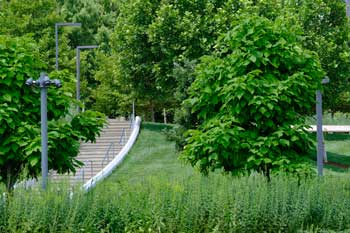
Imagine. A beautiful landscape that works with you, thriving in its setting. Native plant communities can help you create a landscape that works with you. These plant groupings evolved within natural communities to survive and be compatible within an environment.
In Missouri, forest, glade, prairie, savanna, and wetland are our five natural communities. Native plants and their communities can inspire us to think of site qualities as assets. Rather than amending and modifying sites, we can work with appropriate native species. Those that have adapted to similar conditions can help us create stunning landscapes.
Wetlands are an excellent example of a natural community to inspire urban landscapes. Typically, wetlands have sites that are permanently or seasonally flooded. Because of this, their soils are oxygen deprived. Naturally wet areas are home to a variety of trees, grasses, sedges, rushes, and perennials. These can form the nucleus of a beautiful pond garden, bioswale, or rain garden.
But wetland plants also perform well on compacted, anaerobic urban soils. They can tolerate periods of drought and are not affected by high pH soils. Many wetland and swamp species such as sumacs and buttonbush are also salt-tolerant. Salt runoff, salinated soils and dog urine damage plants and soils.
Designing your landscape with natural communities is no different than any landscape design. There are five extra principles for success:
1. Design with landscape goal(s) in mind, for example erosion control or drought-tolerance.
2. Think of natural site quality as an asset. Shade, wet clay, and steep slopes can be assets to create a unique native plant community. Resist the temptation to fertilize. Fertilizers can increase competition with weeds and decrease life expectancy of many natives.
3. Use native plants in three layers to maintain cool soil and discourage competitive weeds. Plant woodies for structure followed by seasonal perennials. Add a ground-cover layer of low-growing plants instead of mulch. This can help prevent the soil from gaining too much organic matter.
4. Make it attractive and legible. Create “frames” around planting beds with grass or paths. Lower landscape planting height is especially important in urban contexts.
5. Think management not maintenance. Natural plant communities evolve through competition, succession, and disturbance. As plants die out, naturalize, and spread, a robust and resilient planting occurs.
Forrest Keeling Nursery supplied much of the plant material for the original planting of St. Louis’ Gateway Arch grounds in the late ’60s. When the Arch grounds were renovated 50 years later, many of Forrest Keeling’s RPM-produced wetland site natives were again the perfect choice. Some of the tree species used included catalpa, buckeye, bald cypress, bur and swamp white oak.
For a list of native wetland species, see Forrest Keeling.com. Forrest Keeling… where the best native plants begin.


